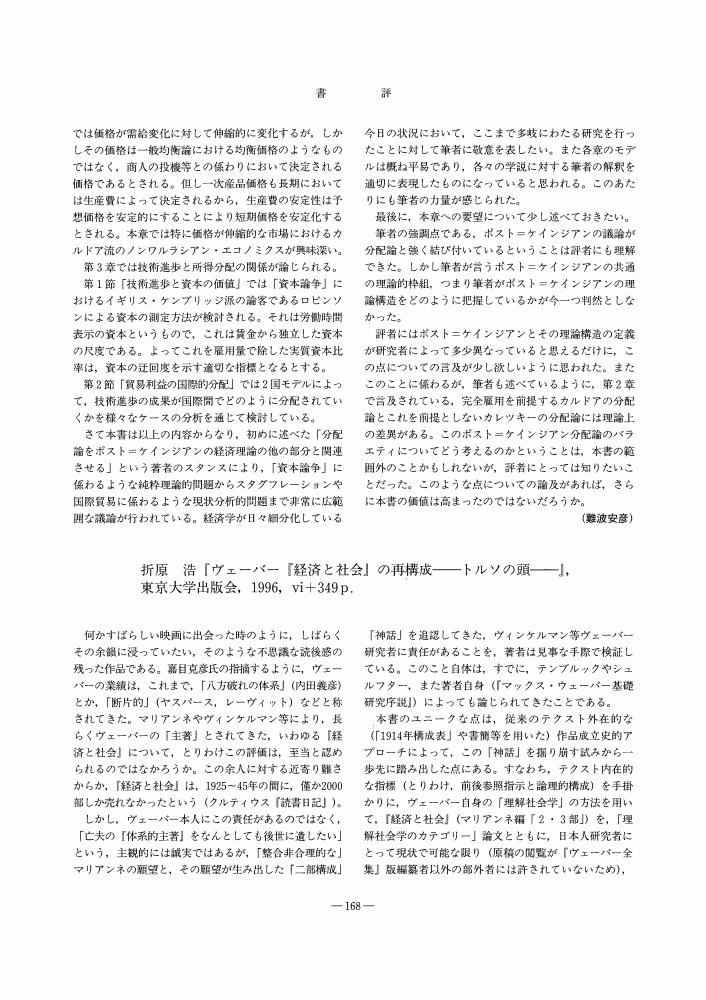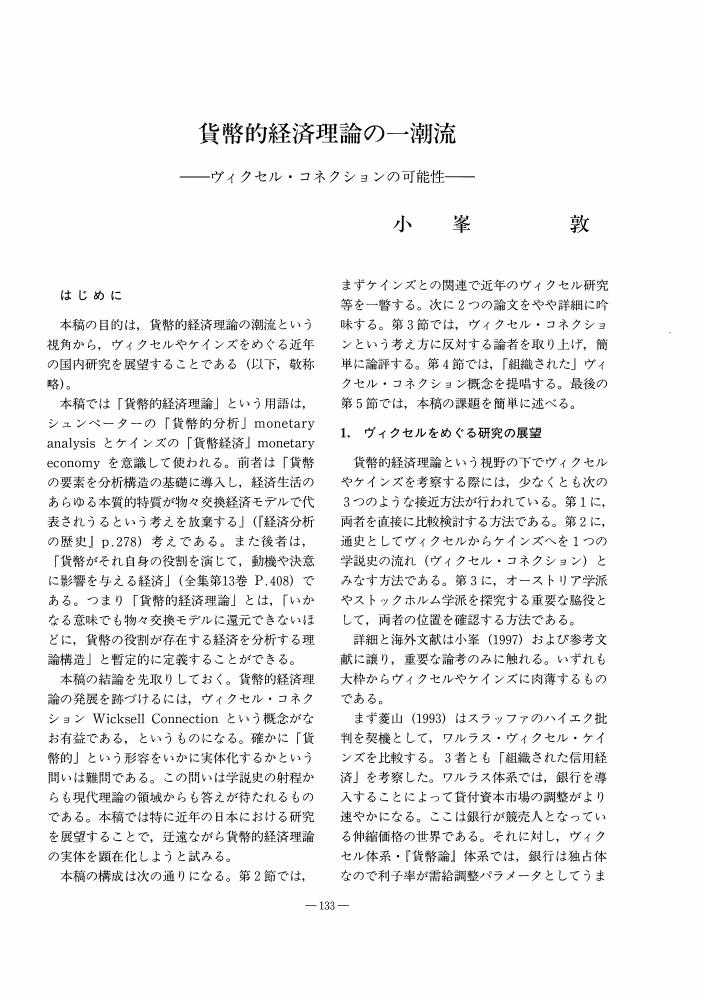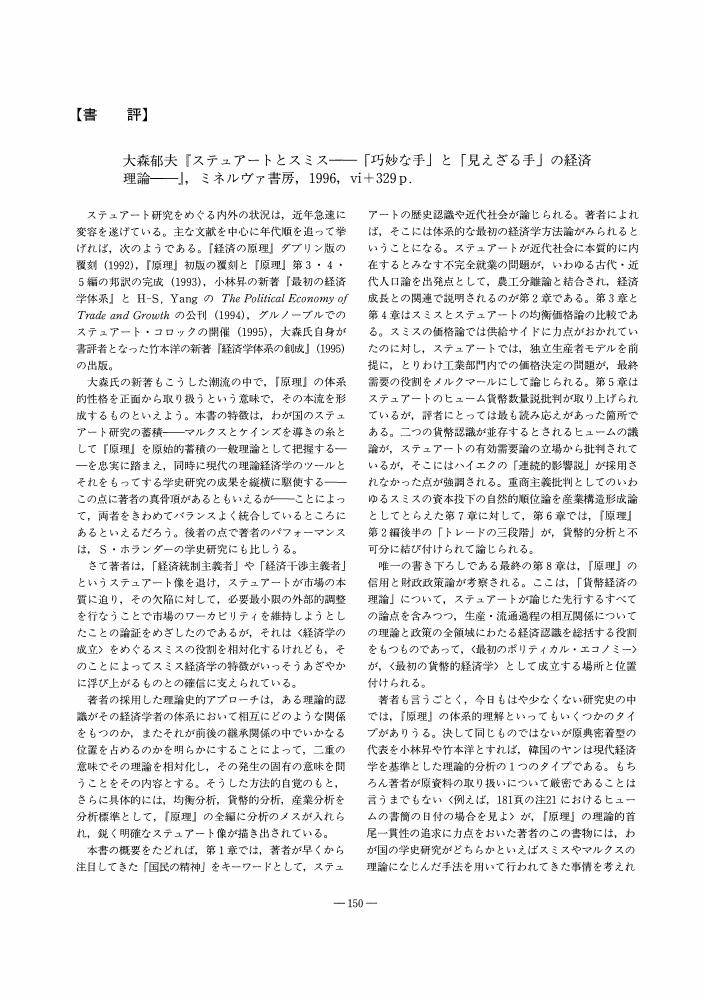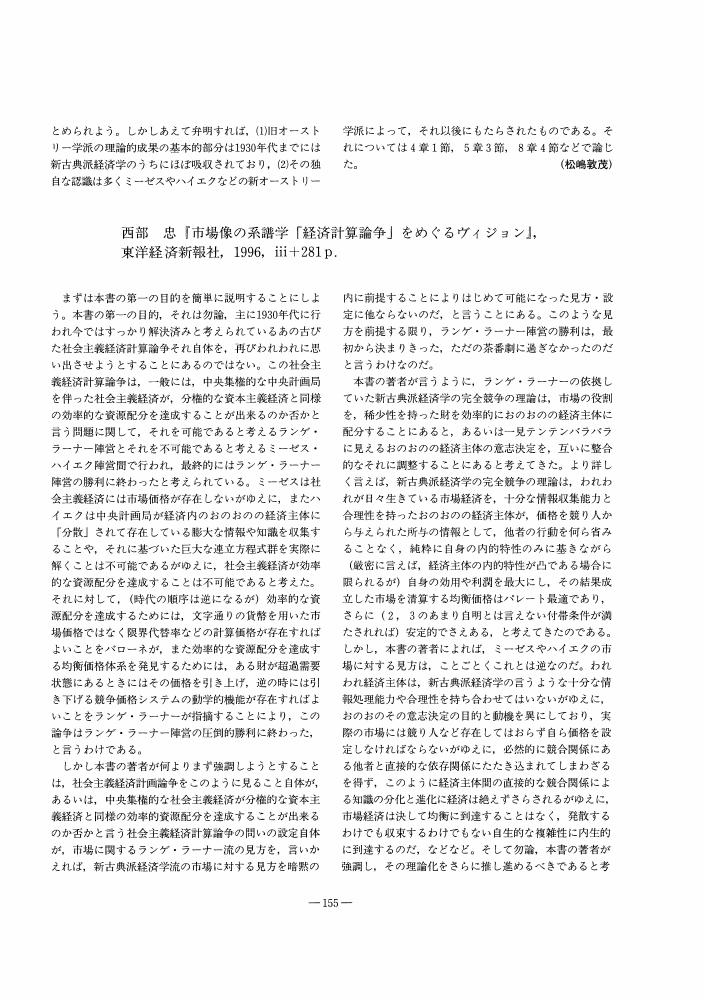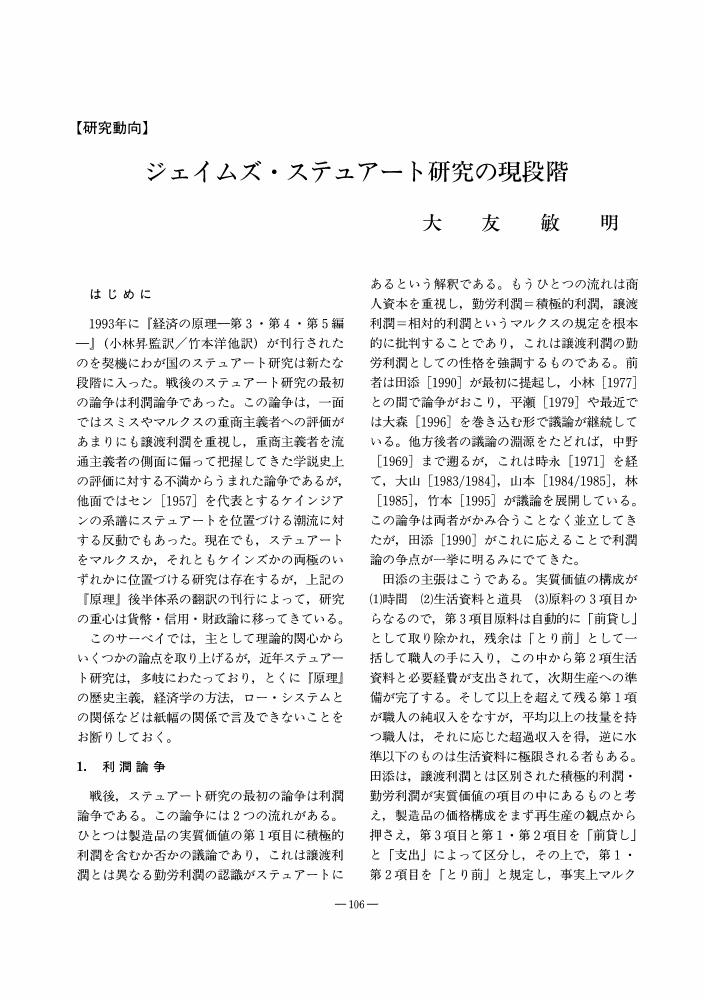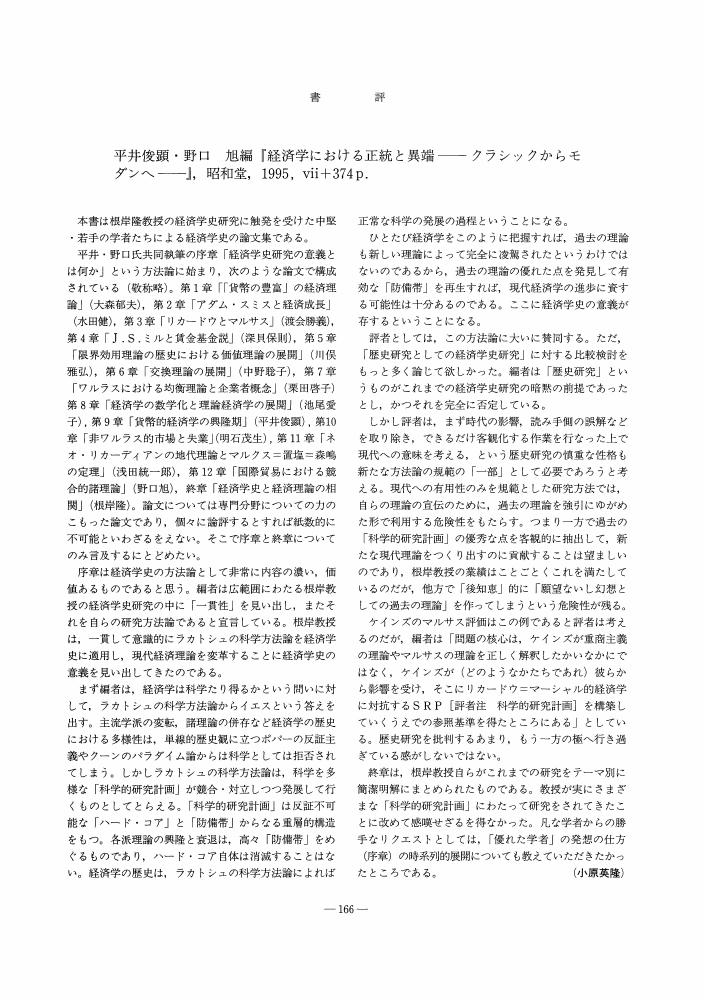- 著者
- 古川 順一
- 出版者
- 経済学史学会
- 雑誌
- 経済学史学会年報 (ISSN:04534786)
- 巻号頁・発行日
- vol.35, no.35, pp.168-170, 1997 (Released:2010-08-05)
- 著者
- 黒須 純一郎 堀田 誠之
- 出版者
- 経済学史学会
- 雑誌
- 経済学史学会年報 (ISSN:04534786)
- 巻号頁・発行日
- vol.35, no.35, pp.170-171, 1997 (Released:2010-08-05)
- 著者
- 太田 仁樹 池尾 愛子
- 出版者
- The Japanese Society for the History of Economic Thought
- 雑誌
- 経済学史学会年報 (ISSN:04534786)
- 巻号頁・発行日
- vol.35, no.35, pp.173-175, 1997 (Released:2010-08-05)
1 0 0 0 OA 古典派経済学と political economy の普及・一般化
- 著者
- 飯田 裕康
- 出版者
- The Japanese Society for the History of Economic Thought
- 雑誌
- 経済学史学会年報 (ISSN:04534786)
- 巻号頁・発行日
- vol.35, no.35, pp.114-124, 1997 (Released:2010-08-05)
- 参考文献数
- 40
1 0 0 0 OA マルクス商品・貨幣論研究の現段階
- 著者
- 正木 八郎
- 出版者
- The Japanese Society for the History of Economic Thought
- 雑誌
- 経済学史学会年報 (ISSN:04534786)
- 巻号頁・発行日
- vol.35, no.35, pp.125-132, 1997 (Released:2010-08-05)
- 参考文献数
- 25
1 0 0 0 OA 貨幣的経済理論の一潮流
- 著者
- 小峯 敦
- 出版者
- The Japanese Society for the History of Economic Thought
- 雑誌
- 経済学史学会年報 (ISSN:04534786)
- 巻号頁・発行日
- vol.35, no.35, pp.133-140, 1997 (Released:2010-08-05)
- 参考文献数
- 48
- 著者
- 渡辺 邦博
- 出版者
- 経済学史学会
- 雑誌
- 経済学史学会年報 (ISSN:04534786)
- 巻号頁・発行日
- vol.35, no.35, pp.150-151, 1997 (Released:2010-08-05)
- 著者
- 渡辺 恵一
- 出版者
- 経済学史学会
- 雑誌
- 経済学史学会年報 (ISSN:04534786)
- 巻号頁・発行日
- vol.35, no.35, pp.151-153, 1997 (Released:2010-08-05)
- 著者
- 渡会 勝義 松嶋 敦茂
- 出版者
- 経済学史学会
- 雑誌
- 経済学史学会年報 (ISSN:04534786)
- 巻号頁・発行日
- vol.35, no.35, pp.153-155, 1997 (Released:2010-08-05)
- 著者
- 荒川 章義 西部 忠
- 出版者
- 経済学史学会
- 雑誌
- 経済学史学会年報 (ISSN:04534786)
- 巻号頁・発行日
- vol.35, no.35, pp.155-157, 1997 (Released:2010-08-05)
- 著者
- 森本 孝
- 出版者
- 経済学史学会
- 雑誌
- 経済学史学会年報 (ISSN:04534786)
- 巻号頁・発行日
- vol.35, no.35, pp.157-158, 1997 (Released:2010-08-05)
1 0 0 0 OA 総力戦・ニューディール・システム社会
- 著者
- 山之内 靖
- 出版者
- The Japanese Society for the History of Economic Thought
- 雑誌
- 経済学史学会年報 (ISSN:04534786)
- 巻号頁・発行日
- vol.35, no.35, pp.28-43, 1997 (Released:2010-08-05)
1) From Modern to Post-Modern in Social ScienceIn this artide, the author reflects on his achievements after 1976. How do these achievements relate to the main question asked by the editorial comittee of the Society of the History of Economic Thought? The main question is: What is the meaning of the economics and/or economic thought during the Great Depression and/or War times?Historical Aspects of the Contemporary Society (1982) and Contemporary Aspects of System Society (1996) are the author's two major works. In the former, he describes the transformation of advanced capitalist societies from ‘class-oriented’ to ‘system-oriented’ in the middle of the 20th century. The latter adds to this investigation two new findings: a) The Total War's mobilization system contributed greatly to the reorientation of society; b) Uncertainty or indeterminacy of the identity is the specific characteristics of contemporary society. The personal identity of the people in the contemporary society is not directly determined by their position in the social structure. It is rather the product of social interchange and negotiation among people.The above is the fundamental idea of the author after 1976, and will here be explored in relation to the following issues.2) Rethinking ‘Karl Marx and Max W eber’3) Total War and ‘Overcoming Modernity’4) Total War and the Rise of System Society5) Total War and Socialism6) New Deal and the Rise of System Society7) J. A. Hobson and J. M. Keynes8) Conclusion
1 0 0 0 OA 戦間期イギリス経済政策とケインズ
- 著者
- 玉井 龍象
- 出版者
- The Japanese Society for the History of Economic Thought
- 雑誌
- 経済学史学会年報 (ISSN:04534786)
- 巻号頁・発行日
- vol.35, no.35, pp.44-58, 1997 (Released:2010-08-05)
- 参考文献数
- 22
The following paraphrases a December 18, 1994 lecture of the late Prof. Tamai. Reviewing recent “revisionist” researches on Keynes's influence on economic policy-making in the interwar-period Britain, the lecturer discussed Keynes as both a policy designer and propagandist from 1919 till his death. In the first and second section of his lecture, Tamai finds peculiar “patriot” traits in Keynes's policy proposal for international economic problems as well as for European security problems in this period. Next, Tamai explains the complicated relationship between Keynes and the formation and modification of the “Treasury View.” Further Keynes's proposal against the depression and his commitment to wartime financing are also discussed. Although the lecturer does not directly answer to question of whether the “Keynesian Revolution in economic policy” existed. In reality, the penetration of the Keynesian idea proceeded gradually under the urgent political climate between 1929 and 1945.
1 0 0 0 OA J. S. ミル相互需要説の先行者
- 著者
- 藤本 正富
- 出版者
- The Japanese Society for the History of Economic Thought
- 雑誌
- 経済学史学会年報 (ISSN:04534786)
- 巻号頁・発行日
- vol.35, no.35, pp.59-71, 1997 (Released:2010-08-05)
The Theory of Reciprocal Demand is best known in the context of the work of John Stuart Mill. Mill's ‘First Elementary Principle of International Value’ first appeared in Essays on Some Unsettled Questions of Political Economy (1844). Before Mill, however, according to Jacob Viner and others, a number of classical economists, including Robert Torrens, Mountifort Longfield, and James Pennington pointed out that terms of trade are determined by reciprocal demand.No graphical approaches are provided in the suggestions of Viner and others. Accordingly, in this paper, we deal with their Theory of Reciprocal Demand using a graphical model based on the first elementary principle of Mill. We then confirm Mill's status as the founder of this theory.
1 0 0 0 OA 奢侈論争と経済学
- 著者
- 米田 昇平
- 出版者
- The Japanese Society for the History of Economic Thought
- 雑誌
- 経済学史学会年報 (ISSN:04534786)
- 巻号頁・発行日
- vol.35, no.35, pp.72-83, 1997 (Released:2010-08-05)
- 参考文献数
- 19
The Luxury controversy caused by the defense of luxury in Mandeville's The Fable of the Bees exerted a great influence on 18th Century France through Melon and Voltaire. This controversy highlighted the coming of “the era of economy, ” and was closely related to the shaping of economics. This paper focuses on a phase of the luxury controversy primarily by examining Forbonnais's theory of luxury and consumption.Forbonnais defines luxury as the desire for a higher level of consumption. Luxurious wants/consumption serve a double economic function; both creating labor incentives and regulating levels of production by stimulating consumption demand. According to Forbonnais, civilized societies are able to progress due to the ubiquitious presence of luxurious wants/consumption. Contrary to this view, Hume, Turgot, and Smith stress saving rather than luxurious wants as the driving force of economic growth.
1 0 0 0 OA アーヴィング・フィッシャーの利子率決定理論
- 著者
- 中路 敬
- 出版者
- The Japanese Society for the History of Economic Thought
- 雑誌
- 経済学史学会年報 (ISSN:04534786)
- 巻号頁・発行日
- vol.35, no.35, pp.84-95, 1997 (Released:2010-08-05)
- 参考文献数
- 31
Irving Fisher's interest theory presented in Rate of Interest (1907) is known by his time preference theory which focuses on the decision-making related to two points in the time.However, his interest theory is based on period, rather than instantaneous, analysis. In this sense, Fisher's theory of interest differs from Böhm-Bawerk's “continuous input and instantaneous output” interest theory, assuming instead “continuous input and continuous output” model. This is an important originality of his interest theory.Fisher's interest theory is divided into three “approximations”. In the first approximation, he presents conditions for the determination of interest rate under the supposition of a single income stream. In the second approximation, considering alternative income streams, he devises the rate of return over cost. In the third approximation, uncertainty is introduced.The conception of uncertainty in Rate of Interest is a theoretical link to Fisher's Appreciation and Interest (1896) and Purchasing Power of Money (1911), since in these later writings, imperfect foresight under uncertainty plays an important role. In this sense, Rate of Interest is a cornerstone for creation of a macro-dynamic, rather than a micro-static, theory.
- 著者
- Yoshihiko YAMAZAKI
- 出版者
- The Japanese Society for the History of Economic Thought
- 雑誌
- 経済学史学会年報 (ISSN:04534786)
- 巻号頁・発行日
- vol.35, no.35, pp.96-105, 1997 (Released:2010-08-05)
- 参考文献数
- 19
The focal point of the problem of the transformation of Keynes's method is determining whether or not he eventually changed the philosophy developed in his 1921 Treatise on Probability. One faction contends that Keynes's method changed and the other that it was constant. In this paper I posit that both viewpoints are at least partially true. In his early stage, Keynes applied his theory of probability both to the researches of economists and the behavior of economic agents. But upon reading Ramsey's critique, ‘Truth and Probability’ (1926), Keynes noticed the danger to which the application of his theory of rational inference to the conduct of economic agents could lead. Subsequently, he adopted the assumption of conventional behavior as seen in his General Theory of Employment, Interest and Money (1936). But he maintained his rational inference as a methodology of economics. We can verify this by reviewing Keynes's critique of Tinbergen's method of macroeconometrics (1939). Considering that Ramsey's optimal growth theory and his expected utility theory are roots of stochastic models of optimal growth theory and real business cycle theory, it is very interesting to notice that the contemporary methodological confrontation between Keynesians and neoclassicists dates back to the birth of macroeconomics.
1 0 0 0 OA ジェイムズ・ステュアート研究の現段階
- 著者
- 大友 敏明
- 出版者
- The Japanese Society for the History of Economic Thought
- 雑誌
- 経済学史学会年報 (ISSN:04534786)
- 巻号頁・発行日
- vol.35, no.35, pp.106-113, 1997 (Released:2010-08-05)
- 参考文献数
- 24
- 著者
- 小室 正紀
- 出版者
- 経済学史学会
- 雑誌
- 経済学史学会年報 (ISSN:04534786)
- 巻号頁・発行日
- vol.34, no.34, pp.168, 1996 (Released:2010-08-05)
